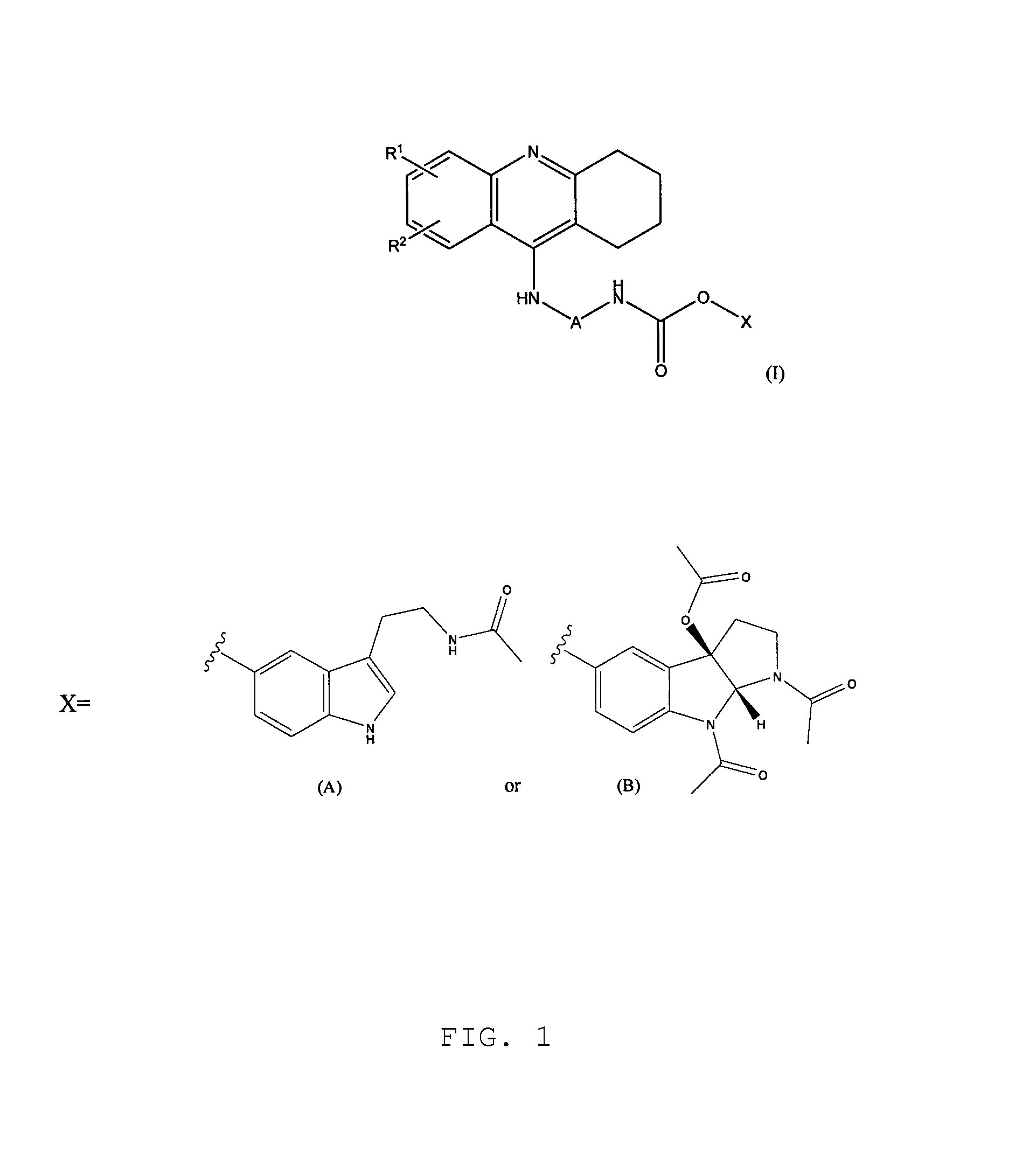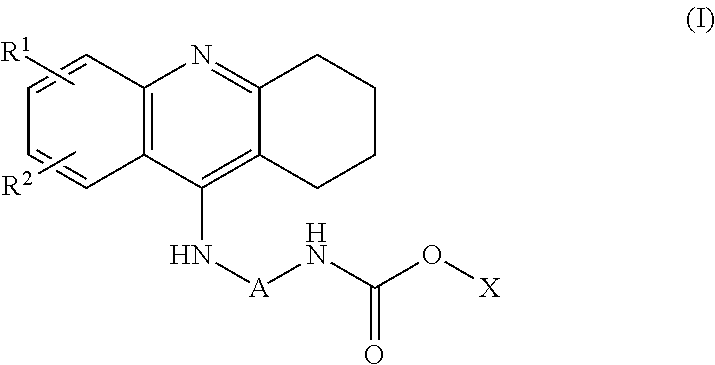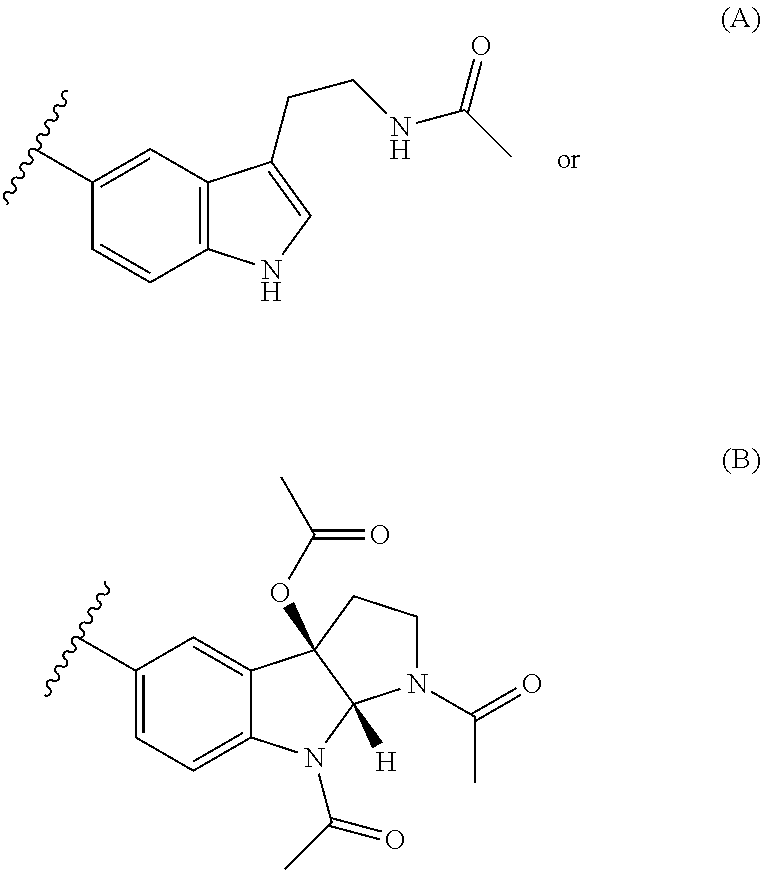Novel hybrid cholinesterase inhibitors
a technology of cholinesterase inhibitors and hybrids, applied in the direction of biocide, heterocyclic compound active ingredients, drug compositions, etc., can solve the problem of no effective causal therapy
- Summary
- Abstract
- Description
- Claims
- Application Information
AI Technical Summary
Benefits of technology
Problems solved by technology
Method used
Image
Examples
example 1
3-[2-(acetylamino)ethyl]-1H-indol-5-yl[7-(1,2,3,4-tetrahydroacridin-9-ylamino)heptyl]carbamate
[0104]
A. 3-[2-(acetylamino)ethyl]-1H-indol-5-yl 4-nitrophenyl carbonate
[0105]To N-acetylserotonin (0.9 g; 4 mmol) was added N-methylmorpholine (0.92 ml, 8 mmol), and 4-nitrophenyl chloroformate (1.61 g; 8 mmol) dissolved in tetrahydrofuran. Reaction was carried out for 0.5 h under an argon atmosphere. The solvent was evaporated. The residue was purified by column chromatography (SiO2, methanol / methylene chloride) to give 0.92 g (yield 60%) of crystalline yellow product with a melting point 153-156° C.
[0106]1H NMR (200 MHz, CDCl3), δ (ppm): 9.34 (br.s, 1H, NH), 8.28 (m, 2H, Harom), 7.48 (m, 2H, Harom), 7.36 (m, 2H, Harom), 7.07 (m, 2H, Harom), 5.72 (br.s, 1H, NH), 3.55 (m, 2H, CH2), 2.92 (m, 2H, CH2), 1.93 (s, 3H, COCH3); 13C NMR (50 MHz, CDCl3), δ (ppm): 170.61, 155.66, 152.23, 145.67, 144.60, 134.73, 127.85, 125.56, 124.20, 121.99, 115.39, 113.57, 112.19, 110.46, 40.09, 25.39, 23.52; MS EI...
example 2
3-[2-(acetylamino)ethyl]-1H-indol-5-yl[2-(1,2,3,4-tetrahydroacridin-9-ylamino)ethyl]carbamate
[0109]
[0110]Following the same procedure as in the Example 1, but starting from compound III, where R1, R2═H, A=(CH2)2 (170 mg; 0.7 mmol), the 51 mg of the title compound was obtained with the yield of 30%.
[0111]1H NMR (500 MHz, CD3OD), δ (ppm): 8.13 (d, J=8.5 Hz, 1H), 7.78 (dd, J1=8.5 Hz, J2=0.5 Hz, 1H), 7.56 (td, J1=7.0 Hz, J2=1.5 Hz, 1H), 7.37 (td, J1=8.0 Hz, J1=1.0 Hz, 1H), 7.27 (d, J=8.5 Hz, 1H), 7.19 (d, J=2.5 Hz, 1H), 7.10 (s, 1H), 6.73 (dd, J1=8.5 Hz, J2=2.0 Hz, 1H), 3.72 (t, J=6.0 Hz, 2H), 3.45-3.40 (m, 4H), 2.98 (t, J=6.0 Hz, 2H), 2.88 (t, J=7.5 Hz, 2H), 2.78 (t, J=6.0 Hz, 2H), 1.91-1.88 (m, 4H), 189 (s, 3H); 13C NMR (125 MHz, CD3OD), δ (ppm): 173.25, 159.17, 158.96, 153.15, 147.75, 145.37, 135.82, 129.86, 128.95, 127.85, 125.01, 125.01, 124.34, 121.28, 117.21, 116.80, 113.64, 112.46, 111.64, 49.85, 42.86, 41.49, 34.13, 26.16, 26.13, 24.08, 23.62, 22.61; MS EI(+)(m / z): 486 [M+H]+; ...
example 3
3-[2-(acetylamino)ethyl]-1H-indol-5-yl[6-(1,2,3,4-tetrahydroacridin-9-ylamino)hexyl]carbamate
[0113]
[0114]Following the same procedure as in the Example 1, but starting from compound III, where R1, R2═H, A=(CH2)6 (174 mg, 0.58 mmola), the 25 mg of the title compound was obtained with the yield of 16%.
[0115]1H NMR (500 MHz, CD3OD), δ (ppm): 8.13 (d, J=8.5 Hz, 1H), 7.76 (dd, J1=8.5 Hz, J2=0.5 Hz, 1H), 7.57 (td, J1=6.5 Hz, J2=1.0 Hz, 1H), 7.38 (td, J1=8.5 Hz, J2=1.5 Hz, 1H), 7.27 (dd, J1=8.5 Hz, 0.5 Hz, 1H), 7.23 (dd, J1=2.0 Hz, J2=0.5 Hz, 1H), 7.10 (s, 1H), 6.80 (dd, J1=8.5 Hz, J2=2.0 Hz, 1H), 3.59 (t, J=6.0 Hz, 2H), 3.14 (t, J=7.5 Hz, 2H), 3.16 (t, J=7.0 Hz, 2H), 2.97 (t, J=6.5 Hz, 2H), 2.87 (t, J=7.0 Hz, 2H), 2.73 (t, J=5.5 Hz, 2H), 1.92-1.85 (m, 4H), 1.89 (s, 3H), 1.72-1.67 (m, 2H), 1.57-1.52 (m, 2H), 1.43-1.38 (m, 4H); 13C NMR (125 MHz, CD3OD), δ (ppm): 173.41, 158.72, 158.35, 154.01, 147.10, 145.68, 135.92, 130.41, 129.14, 127.13, 125.07, 125.07, 124.83, 120.96, 117.05, 116.51, 11...
PUM
| Property | Measurement | Unit |
|---|---|---|
| pH | aaaaa | aaaaa |
| Oxidative stress | aaaaa | aaaaa |
| antioxidant properties | aaaaa | aaaaa |
Abstract
Description
Claims
Application Information
 Login to View More
Login to View More - R&D
- Intellectual Property
- Life Sciences
- Materials
- Tech Scout
- Unparalleled Data Quality
- Higher Quality Content
- 60% Fewer Hallucinations
Browse by: Latest US Patents, China's latest patents, Technical Efficacy Thesaurus, Application Domain, Technology Topic, Popular Technical Reports.
© 2025 PatSnap. All rights reserved.Legal|Privacy policy|Modern Slavery Act Transparency Statement|Sitemap|About US| Contact US: help@patsnap.com



